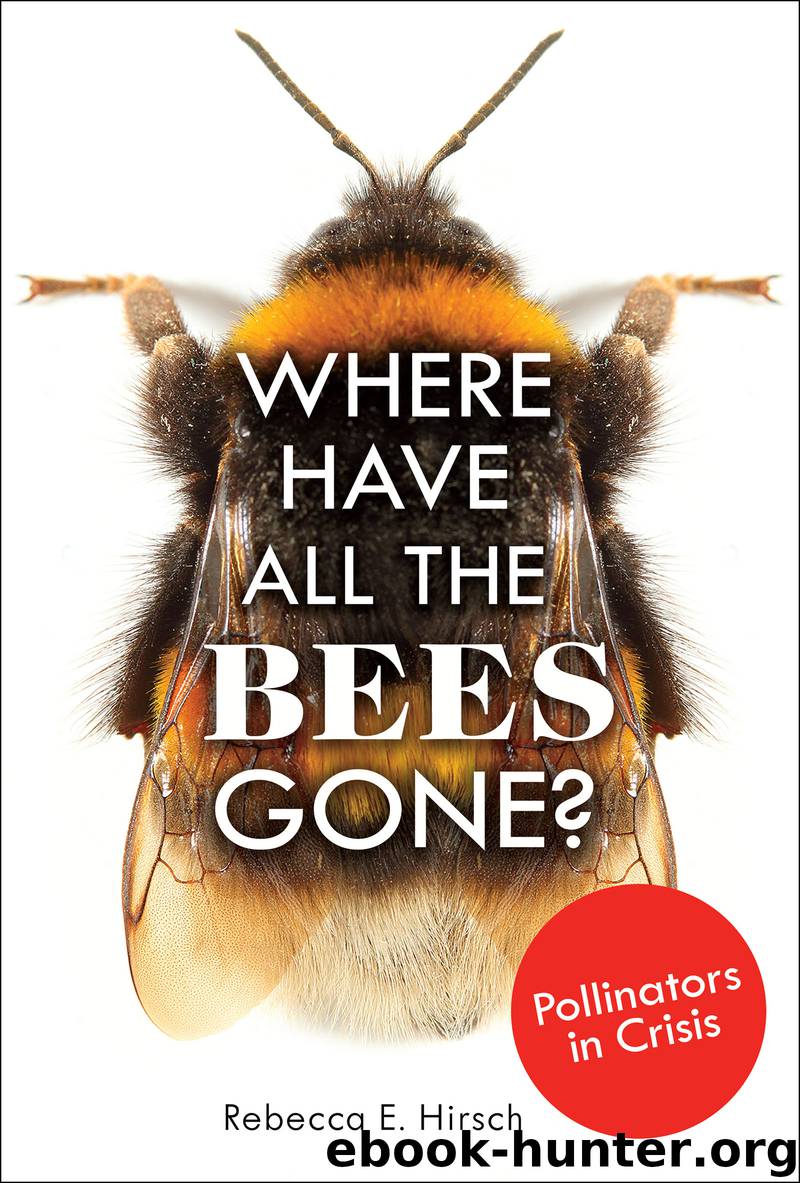Where Have All the Bees Gone? by Rebecca E. Hirsch

Author:Rebecca E. Hirsch [Hirsch, Rebecca E.]
Language: eng
Format: epub
Tags: Nonfiction, Young Adult Nonfiction, Young Adults, Animals, Animal, Animal Welfare, Science & Nature, Environment, Environmental Conservation & Protection, Conservation, Protection, Environmental Science, Ecosystem, Ecosystems, Environmental Science & Ecosystems, Agriculture, America, American bumblebee, angiosperm, Animal Behavior, Animal Behaviors, Animal Characteristics, Anther, Bee, bee care, Bee Hive, Bee Hives, Bee Intelligence, bee reproduction, Bee Research, bee sting, bee stings, bee theory, Beehives, Beekeeper, Beekeepers, Beekeeping, beesting, Beeswax, Behavior, Biology, blueberry bee, Bombus, Buzz, carlinville, Charles Darwin, Climate Change, Colony, Colony Collapse Disorder, commercial beekeeper, commercial beekeepers, Conifer, cuckoo Bees, Culture, Darwinism, Deoxyribonucleic Acid, Diversity, DNA, Drone, Earth, Ecologist, Economy, Endangered Species Act, entomologist, Evolution, Evolve, Extinct, Extinction, Farming, farming bees, Fertilization, flower gardens, flowering plants, Flowers, Food, Foods, forage, Franklin's bumblebees, Fungus, Generations, Geography, Global Warming, Globe, Habitat, Habitats, History, Honey, Honeybee, Honeycomb, Honeycombs, Industrial farms, Insect, Insects, Invention and Technology, Invertebrate, Land, Larvae, Lerner, Lerner Publications Company, Lerner Publishing Group, Life Cycle, Life Cycles, Life Science, Map, meat-eating wasps, mining bees, Native, Natural Selection, Naturalist, Nature, Nectar, Neonicotinoids, nosema bombt, Parasite, Parasites, Pathogen, pesticide, pesticide poisoning, Pesticide Use, Pesticides, Physical Characteristics, Planet Earth, Plant, plant evolution, plant gender, plant genders, plant pollination, plant pollinator, plant reproduction, Plants, Pollen, Pollinate, Pollination, pollination by hand, pollination farms, pollination transfer, pollinator, Pollinators, Pollinators in Crisis, Pollution, Population, Predator, Predators, Queen, Queen Bee, Queen Bees, Rachel Carson, range, Rebecca E. Hirsch, Robbin Thorp, rusty patched bumblebee, Science, Nature & How It Works, and How It Works, Scientist, Scientists, Species, Static, Stem, Stingers, Sun, TFCB, Timeline, Tools and Technology, Twenty First Century Books, Twenty-First Century Books, U.S., Vibration, Vibrations, Wasp, Wasps, Water, Weather, western bumblebee, Where Have All the Bees Gone?, wild pollinators, Wildlife, wind pollination, Worker, Worker Bee, Worker Bees, yellow-branded bumblebee
Publisher: Lerner Publishing Group
Published: 2020-01-02T00:00:00+00:00
Too Fat to Fly?
If Nosema bombi was indeed the culprit, how exactly was it causing bumblebee declines? Jamie Strange has been trying to answer this question. He has been trying to figure out exactly how the pathogen affects the western bumblebee.
He has discovered that when Nosema bombi takes root in a colony, the males are hardest hit. “The males become really, really infected,” he said. “Their abdomens become distended [swollen] from having all these spores of this fungus. In many cases they can’t really fly, and those that can fly, can’t fly for very long.”
Strange thinks that infection could interrupt mating. His hypothesis is that an infected male, with its abdomen swollen, can’t fly off to find a queen to mate with. Or perhaps it can’t mate with a queen once it has found one. And without mating, next year’s colony falls apart. A queen bumblebee can lay male offspring without her eggs being fertilized. But she can lay females only after she has mated. And since females do all the work of maintaining the colony, without females, the colony starves.
Strange is having a hard time proving his theory. The problem is that his team can’t find western bumblebees that are free of the disease. Every nest they collect from the wild for their experiments is infected. Without a supply of Nosema-free western bumblebees, they can’t run a controlled experiment—one that would enable them to compare infected bees with uninfected bees. “That’s been our biggest challenge,” he said, “getting clean [healthy] bees.”
Other questions remain. One of the most puzzling is, If native American bumblebees have been exposed to Nosema bombi for decades—as was demonstrated by screening the museum collections—what changed in the 1990s to cause infection rates to spike?
Risky Buzziness
Bee scientists have been advocating for better regulation of the commercial bumblebee business. They say the government regulations in place are not adequate to minimize the risks of disease spillover. They say some steps are needed: halting the shipment of bees outside their native ranges, improved screening for a wider range of pathogens within bumblebee factories, improved hygiene to eliminate pathogens within bumblebee factories, and improved barriers on greenhouses to avoid mixing of managed bees and wild bees.
“Bumblebees are marvelous pollinators and I really wouldn’t want to see the industry come to a halt,” says Robbin Thorp. “But I would like to see a lot more protection of the potential environmental risk.”
Download
This site does not store any files on its server. We only index and link to content provided by other sites. Please contact the content providers to delete copyright contents if any and email us, we'll remove relevant links or contents immediately.
The Lonely City by Olivia Laing(4120)
Animal Frequency by Melissa Alvarez(3755)
All Creatures Great and Small by James Herriot(3516)
Walking by Henry David Thoreau(3234)
Exit West by Mohsin Hamid(3183)
Origin Story: A Big History of Everything by David Christian(3139)
COSMOS by Carl Sagan(2950)
How to Read Water: Clues and Patterns from Puddles to the Sea (Natural Navigation) by Tristan Gooley(2855)
Hedgerow by John Wright(2776)
The Inner Life of Animals by Peter Wohlleben(2766)
Origin Story by David Christian(2683)
How to Read Nature by Tristan Gooley(2665)
Project Animal Farm: An Accidental Journey into the Secret World of Farming and the Truth About Our Food by Sonia Faruqi(2661)
How to Do Nothing by Jenny Odell(2645)
A Forest Journey by John Perlin(2587)
Water by Ian Miller(2584)
The Plant Messiah by Carlos Magdalena(2453)
A Wilder Time by William E. Glassley(2363)
Forests: A Very Short Introduction by Jaboury Ghazoul(2335)
